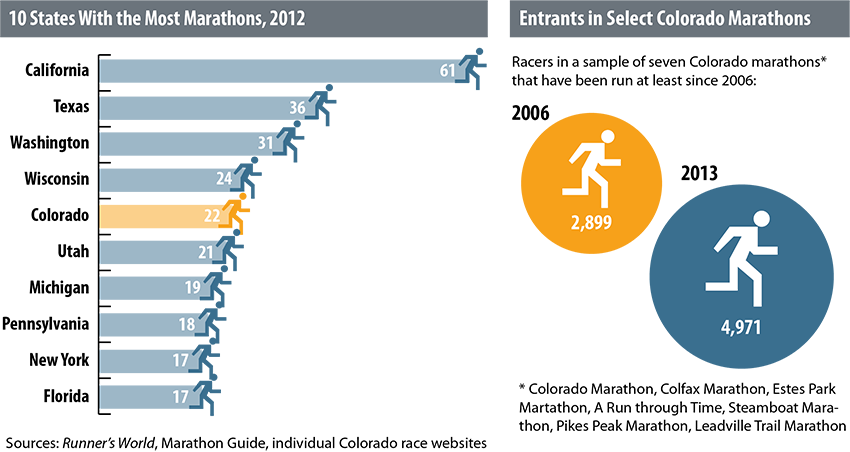September is prime training season for many marathoners, about a month before some of the nation’s most popular races, including the New York City Marathon and the Philadelphia Marathon. Colorado, despite the lack of an internationally known race, is a major contender in the marathon world.
Colorado ranks fifth among states for the number of marathons, even though it is 22nd when it comes to population. The two largest states, California and Texas, rank first and second, according to a Runner’s World analysis of the Marathon Guide database.
Colorado ranks 22nd in population. Its number of marathons, given its modest population size, is a testament to its residents’ passion for the outdoors and fitness, as well as the state’s reputation as a destination for physically active travelers.
Coloradans’ desire to endure a 26.2 mile race has grown over the years. In a selection of seven popular Colorado marathons examined by CHI, the participation rate increased 71.5 percent on average from 2,899 to 4,971 between 2006 and 2013, although two marathons in the sample group saw a slight decline.
Here are the seven sampled marathons, with the number of runners in 2013 and their changes since 2006.
- Colorado Marathon: 1,086 runners, up 72.7 percent from 629 runners in 2006.
- Colfax Marathon: 1,206 runners, up 50 percent from 804 runners in 2006.
- Estes Park Marathon: 128 runners, down 12.9 percent from 147 runners in 2006.
- A Run through Time: 163 runners, up 181 percent from 58 runners in 2006.
- Steamboat Marathon: 259 runners, down 20.3 percent from 325 runners in 2006.
- Pikes Peak Marathon: 1,641 runners, up 135.1 percent from 698 runners in 2006.
- Leadville Marathon: 488 runners, up 105 percent from 238 runners in 2006.
There is increasing evidence for the benefits of physical activity. The Mayo Clinic presents seven great benefits of exercise, some of which are well known and others that may be surprising. The more common benefits include burning calories to maintain a healthy weight and the release of specific chemicals in the brain to make runners feel happier and more relaxed. But exercise can also boost energy levels by delivering oxygen to the body’s tissues and helping the cardiovascular system work more efficiently. Physical activity can also improve sleep cycles, helping runners fall asleep faster and deepen their sleep after a long day of work.
Of course, marathon running is not the only way to reap the benefits of exercise. Adults ages 18-64 can benefit from just 150 minutes of moderate physical activity a week, about 21 minutes a day. Walking, heavy cleaning like washing windows, and mowing the lawn are all examples of moderate physical activity. For additional benefits, adults can engage in moderate physical activity for 300 minutes a day or 150 minutes of vigorous activity, such as hiking or jogging.

